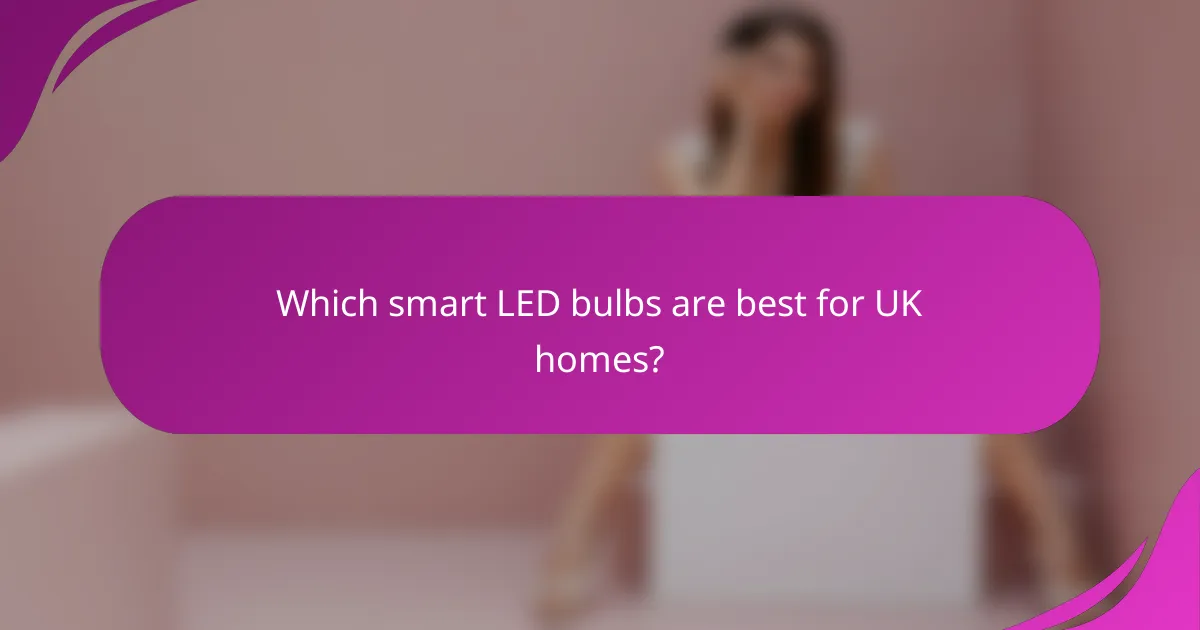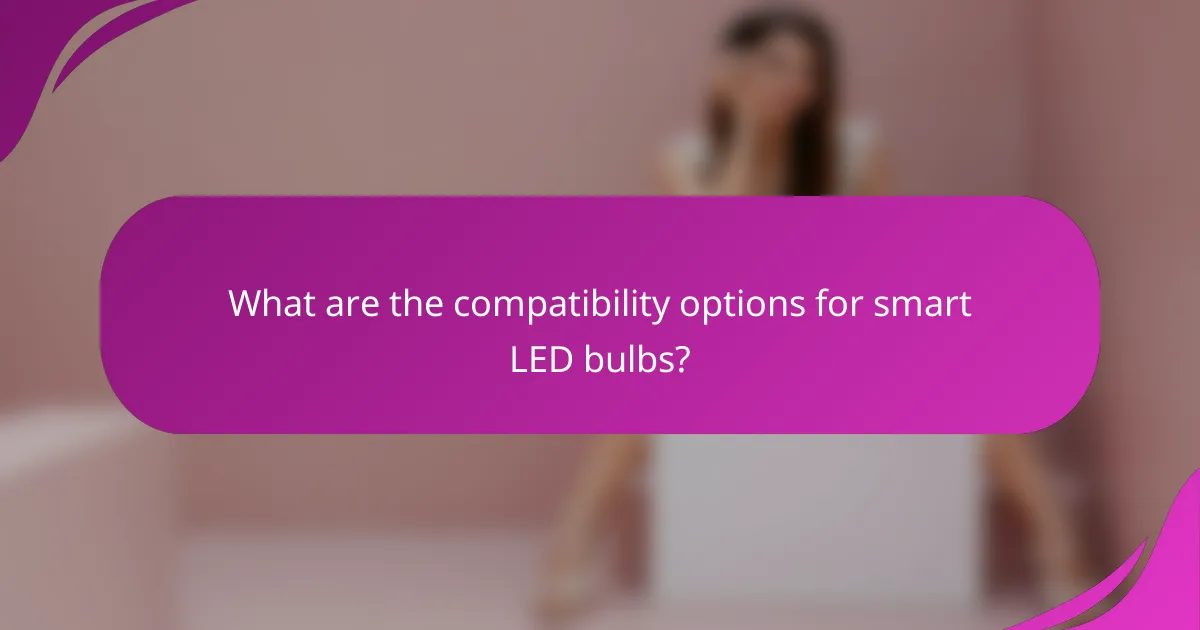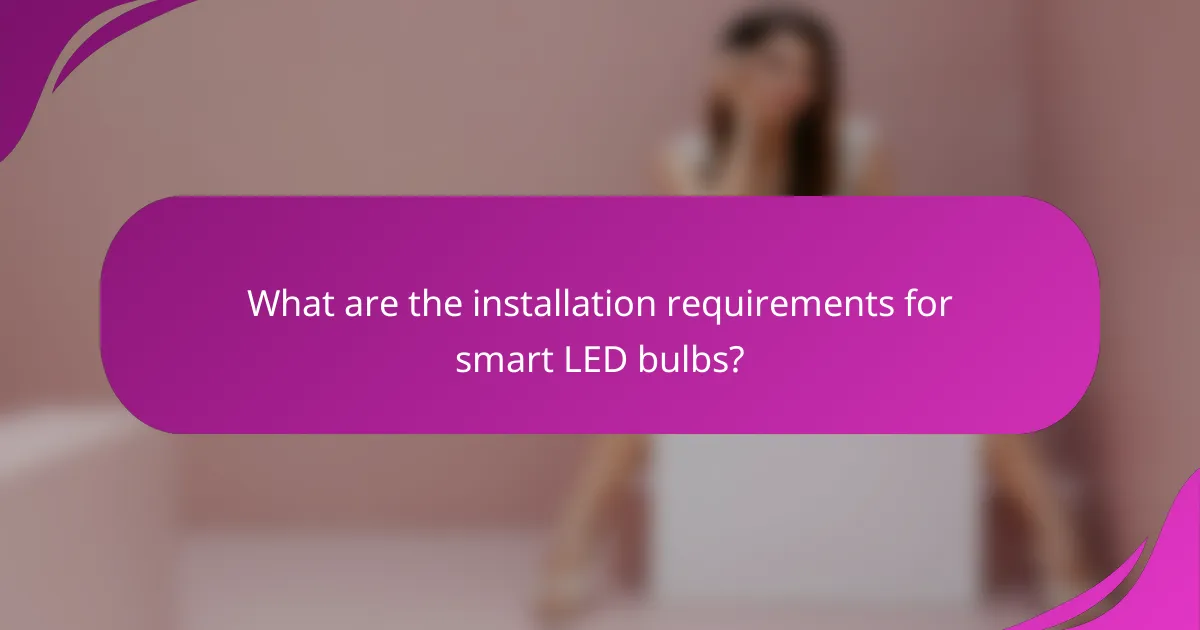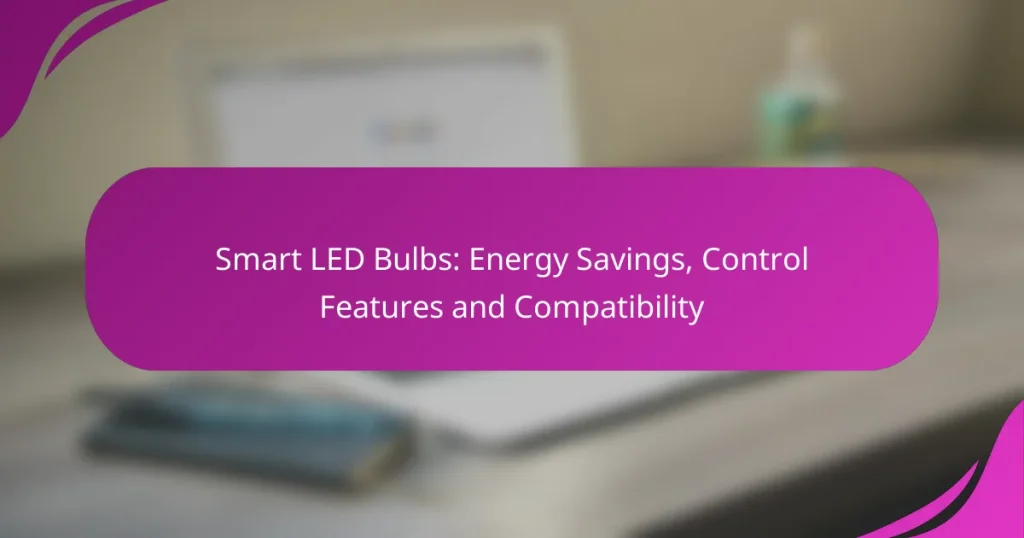Smart LED bulbs are an innovative lighting solution that significantly reduce energy consumption while offering advanced control features for enhanced convenience. With their longer lifespan and ability to be managed remotely or via voice commands, these bulbs not only lower energy bills but also contribute to a more sustainable lifestyle. Compatible with various smart home systems, popular options like Philips Hue and TP-Link Kasa cater to diverse user preferences and needs.

How do smart LED bulbs save energy?
Smart LED bulbs save energy primarily through their reduced power consumption, longer lifespan, and advanced scheduling features. These bulbs are designed to use significantly less electricity compared to traditional incandescent or halogen bulbs, leading to lower energy bills and a smaller carbon footprint.
Reduced power consumption
Smart LED bulbs typically consume about 75% less energy than traditional incandescent bulbs. For example, a standard 10-watt LED can produce the same brightness as a 60-watt incandescent bulb. This efficiency not only reduces electricity costs but also decreases the demand on power plants, contributing to a greener environment.
When selecting smart LED bulbs, look for those with the ENERGY STAR label, which indicates they meet strict efficiency guidelines. This can help ensure you are making a cost-effective choice that maximizes energy savings.
Longer lifespan
Smart LED bulbs have a lifespan of approximately 15,000 to 25,000 hours, significantly outlasting traditional bulbs, which may only last about 1,000 hours. This longevity means fewer replacements and less waste, making them a more sustainable option over time.
With their extended lifespan, smart LED bulbs can also save money on replacement costs and reduce the hassle of frequent bulb changes. Consider this factor when calculating the overall savings from switching to smart lighting.
Smart scheduling features
Many smart LED bulbs come equipped with scheduling features that allow users to set specific times for the lights to turn on or off. This capability can lead to additional energy savings by ensuring lights are only used when needed, such as during evening hours or when someone is home.
Utilizing smart home systems, you can automate lighting based on your daily routines. For instance, programming lights to turn off during the day when no one is home can further enhance energy efficiency and reduce unnecessary power usage.

What control features do smart LED bulbs offer?
Smart LED bulbs provide a variety of control features that enhance convenience and customization. Users can manage their lighting remotely, utilize voice commands, and adjust settings to suit their preferences.
Remote control via smartphone apps
Smart LED bulbs can be controlled through dedicated smartphone applications, allowing users to turn lights on or off, dim them, or change colors from anywhere with an internet connection. Most apps are compatible with both iOS and Android devices, making them accessible to a wide range of users.
When choosing a smart bulb, consider the app’s user interface and features. Some apps offer scheduling options, enabling users to set specific times for lights to turn on or off, which can enhance energy savings and security.
Voice control compatibility
Many smart LED bulbs are compatible with popular voice assistants like Amazon Alexa, Google Assistant, and Apple HomeKit. This allows users to control their lighting with simple voice commands, providing a hands-free experience that can be particularly useful when multitasking.
To ensure compatibility, check the specifications of the smart bulb and the voice assistant you plan to use. Setting up voice control typically involves linking the bulb to the assistant’s app and following a few straightforward steps.
Customizable lighting settings
Smart LED bulbs offer customizable lighting settings, including brightness levels, color temperatures, and even color options. Users can create different moods or atmospheres by adjusting these settings according to the time of day or activity.
For instance, a warm white light may be ideal for relaxing evenings, while brighter, cooler tones can enhance focus during work hours. Many apps also allow users to save their preferred settings as presets for quick access in the future.

Which smart LED bulbs are best for UK homes?
The best smart LED bulbs for UK homes combine energy efficiency, advanced control features, and compatibility with various smart home systems. Popular options include Philips Hue, TP-Link Kasa Smart Bulbs, and Wyze Bulbs, each offering unique benefits tailored to different user needs.
Philips Hue
Philips Hue bulbs are renowned for their extensive range of colors and brightness settings, making them ideal for creating customized lighting experiences. They connect seamlessly with smart home systems like Amazon Alexa and Google Assistant, allowing for voice control and automation.
Consider the Philips Hue Bridge for enhanced functionality, enabling remote access and integration with other smart devices. While the initial investment may be higher, the energy savings and versatility can justify the cost over time.
TP-Link Kasa Smart Bulbs
TP-Link Kasa Smart Bulbs offer a budget-friendly option without sacrificing quality. These bulbs provide easy setup through the Kasa app and are compatible with major voice assistants, ensuring straightforward control.
They feature adjustable brightness and color temperatures, allowing users to tailor their lighting to different activities. With energy-efficient designs, TP-Link Kasa bulbs can help reduce electricity bills while enhancing home ambiance.
Wyze Bulbs
Wyze Bulbs are an economical choice for those looking to dip their toes into smart lighting. They are easy to install and can be controlled via the Wyze app, which supports scheduling and automation features.
Although they may not offer as many color options as Philips Hue, Wyze Bulbs still provide adjustable white light settings. Their affordability and energy efficiency make them a practical option for budget-conscious consumers in the UK.

How do I choose the right smart LED bulb?
Choosing the right smart LED bulb involves considering compatibility with your existing systems, evaluating brightness and color options, and assessing energy efficiency ratings. These factors will help you select a bulb that meets your needs while maximizing performance and savings.
Consider compatibility with existing systems
Before purchasing a smart LED bulb, check its compatibility with your current smart home ecosystem, such as Amazon Alexa, Google Assistant, or Apple HomeKit. Some bulbs may require specific hubs or apps for operation, which can limit your options.
For example, if you already use Philips Hue lights, you might want to stick with that brand for seamless integration. Always verify the specifications and user reviews to ensure smooth functionality with your existing devices.
Evaluate brightness and color options
Smart LED bulbs come in various brightness levels, typically measured in lumens, and a range of color temperatures, from warm white to cool daylight. A bulb with around 800 lumens is suitable for general lighting, while higher lumens are better for task lighting.
Additionally, consider whether you want a bulb that can change colors or just adjust brightness. Color-changing bulbs can enhance ambiance for different occasions, while adjustable white bulbs can help set the right mood for work or relaxation.
Assess energy efficiency ratings
Energy efficiency is crucial when selecting smart LED bulbs, as they can significantly reduce electricity costs. Look for bulbs with an ENERGY STAR rating, which indicates they meet strict efficiency guidelines.
Most smart LED bulbs use about 8-12 watts, providing substantial energy savings compared to traditional incandescent bulbs, which can use 60 watts or more. Over time, the reduced energy consumption can lead to savings of tens of dollars annually, making smart bulbs a cost-effective choice.

What are the compatibility options for smart LED bulbs?
Smart LED bulbs offer a variety of compatibility options that enhance their functionality and integration into your home. Key considerations include their ability to connect with smart home ecosystems, voice assistants, and dimmer switches, which can significantly influence your overall user experience.
Integration with smart home ecosystems
Smart LED bulbs can integrate seamlessly with various smart home ecosystems such as Google Home, Amazon Alexa, and Apple HomeKit. This integration allows users to control their lighting through a central hub or app, enabling automation and scheduling features.
When selecting bulbs, ensure they are compatible with your existing ecosystem. For example, Philips Hue bulbs work well with multiple platforms, while other brands may be limited to specific systems. Check for compatibility before purchasing to avoid connectivity issues.
Compatibility with voice assistants
Many smart LED bulbs support voice control through popular voice assistants like Amazon Alexa, Google Assistant, and Apple Siri. This feature allows users to adjust brightness, change colors, or turn lights on and off using simple voice commands.
To utilize voice control, ensure that the smart bulbs you choose are compatible with your preferred voice assistant. Setting up voice commands typically involves linking the bulbs to the assistant’s app, which is usually straightforward and user-friendly.
Support for various dimmer switches
Smart LED bulbs may not be compatible with all dimmer switches, which can affect their performance. Some bulbs require specific types of dimmers that are designed for LED technology to avoid flickering or buzzing.
When integrating smart bulbs with dimmer switches, look for those labeled as “LED compatible.” It’s advisable to consult the manufacturer’s guidelines or customer reviews to ensure optimal performance and avoid common pitfalls associated with incompatible dimmers.

What are the installation requirements for smart LED bulbs?
Installing smart LED bulbs typically requires a compatible light fixture and a stable Wi-Fi or Bluetooth connection for control. Ensure your existing sockets match the bulb type, and consider any app or hub needed for full functionality.
Standard socket types
Smart LED bulbs come in various standard socket types, including E26, E27, GU10, and B22. It’s essential to check the socket type of your fixtures before purchasing to ensure compatibility. Most smart bulbs are designed to fit standard light sockets, but specialty bulbs may require adapters.
For example, E26 and E27 are common in North America and Europe, respectively, while GU10 is often used in track lighting. Always verify the bulb’s specifications to avoid installation issues.
Wi-Fi or Bluetooth connectivity
Smart LED bulbs typically connect via Wi-Fi or Bluetooth, impacting how you control them. Wi-Fi bulbs can be controlled remotely through an app, allowing for more extensive features like scheduling and integration with smart home systems. Bluetooth bulbs, while simpler, usually require proximity for control and may have limited features.
When choosing between the two, consider your home network setup and how you plan to use the bulbs. Wi-Fi options may offer better functionality for larger homes, while Bluetooth can be a cost-effective choice for smaller spaces.


